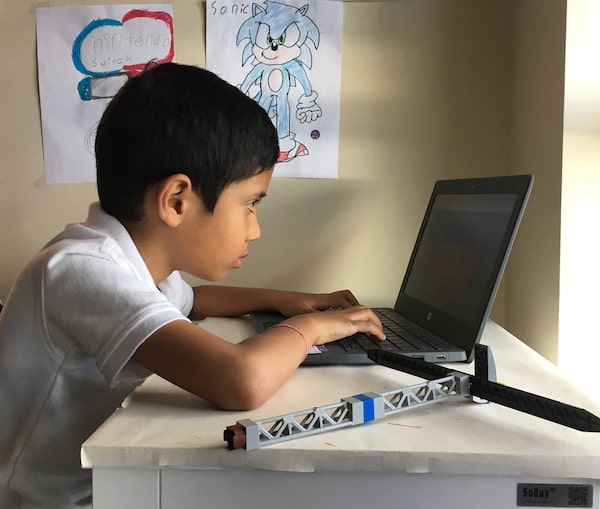
Manu Persaud, who is seven years old and in Grade 2, learns to type on a Chromebook his family recently borrowed from the Toronto District School Board.Supplied
When schools shut down last spring, Nero Persaud balanced working from home and her two children’s remote-learning needs by “playing musical chairs” with her older laptop and iPad.
But after deciding to enrol her son and daughter in online schooling this fall, the Toronto mother signed up to borrow devices from the school board because she knew they would all require their own computers.
“The device has become a standard part of the educational arsenal, the same way as books and pencils,” said Ms. Persaud, a single parent who works in marketing.
Despite efforts by school boards to provide computers to students who need them for virtual schooling, many parents and experts worry the expansion of e-learning is exacerbating the gap between families who have access to computers and broadband internet and those who do not.
“The digital divide is real,” said Beyhan Farhadi, a postdoctoral researcher at York University who studies equity and e-learning. “The way we talk about the digital age – ‘We’re all connected and we’re all online’ – is actually not the reality on the ground.”
In addition, given scarce funding, many of the computers that school boards have lent to online learners were pulled out of classrooms, creating a flashpoint for tensions about reduced access in bricks-and-mortar schools at a time when digital skills are considered essential.
The Toronto District School Board (TDSB) lent 60,000 Chromebooks and iPads to students for remote learning last spring after schools closed because of the coronavirus pandemic. Nearly 40,000 were removed from schools – many of which were bought with the proceeds of parent fundraisers – and the majority have not yet been returned or replaced.
“I’m all for helping kids in need. Absolutely. What was done needed to be done at that time,” said David Shory, chair of the school council at Diefenbaker Elementary School and a former TDSB trustee. “But they needed to better accommodate those kids that had families that chose in-school learning. I think the board’s failed … those kids.”
Peter Singh, the TDSB’s executive officer of IT, said with limited funding, the board is prioritizing providing computers to students enrolled in virtual school who don’t have a device. Of the TDSB’s 238,500 students, 32 per cent are learning online.
“If an asset has been brought into TDSB schools, then it becomes the TDSB asset and the TDSB considers that it needs to move around wherever the need is,” he said. “Right now, this fall, the need is somewhere else, not in that school.”
The board recently bought 9,400 new Chromebooks to replace some of the devices removed from classrooms, Mr. Singh said. The TDSB has not asked for the return of the 60,000 devices lent out last spring because officials expected some of those families would opt for online learning this fall and also in case of another school closing, he said. About 2,000 of the devices were returned by students who graduated or left the board.
Toronto mother Julie Sternberg became concerned last month when her daughter’s Grade 7 teacher asked parents to consider sending their children to school with their own computers because the class set of Chromebooks had been redistributed.
“What about the kids who don’t have one?” said Ms. Sternberg, a sales representative. “It’s all about equity.”
While Ms. Sternberg planned to have her daughter bring her laptop to class, she later learned the school had received a limited number of new Chromebooks from the TDSB. Still, she remains concerned about fairness for other students.
Mr. Singh said the TDSB’s policy is that students may bring their own devices to school but that it is not a requirement.
While online learning is most prevalent in Ontario, school boards in other provinces are also trying to ensure students have devices. Edmonton’s public school board has lent 6,500 Chromebooks to students enrolled in virtual schooling and has redistributed devices across schools so students attending in-person classes “have equitable access,” said spokeswoman Megan Normandeau.
As school boards rushed to set up online learning programs for the fall, Ms. Farhadi said they largely did not detail the range of resources required for students to be successful.
“I worry about really well-intentioned school boards that produce the demand without being clear about what the caregiver or parent could expect in terms of what supports needed to be provided,” she said.
In addition to technology, Ms. Farhadi, who is also a high-school teacher, said students' ability to succeed in virtual schooling depends on other less obvious supports that are a barrier for many families.
Many students, especially younger ones, require an adult to be present to oversee and motivate their learning while also providing technological assistance, which is a challenge for working parents. Students also need a quiet space, which isn’t always possible, she said.
“The way that support looks in different households will really get into the more nuanced pieces of inequities because there’s only so much a teacher can do in the perfect scenario.”
Our Morning Update and Evening Update newsletters are written by Globe editors, giving you a concise summary of the day’s most important headlines. Sign up today.